The annual Mercer rankings are out and Vienna comes top for the eighth year running as the best city in terms of quality of life, measured on public services, political climate and recreation (including arts).
London is 40th, New York 44th.
Here’s the top 20:

12 Amsterdam, Netherlands
15 Wellington, New Zealand
… disaster.
Or, as I put it in the Lebrecht Album of the Week:
This is one of those treasurable major-label releases, made with the best of intentions, in which everything turns out wrong.
Read the full review here.
And here.
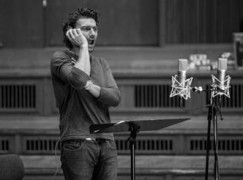
And here.
We hear the rising Birmingham star will conduct the Met orchestra at Carnegie Hall on May 18, 2018, with Anita Rachvelishvili as soloist. She has yet to work in the Metropolitan Opera itself.
Also in the Met orch season at Carnegie Hall is a Pretty Yende concert on June 5, 2018, singing Mozart’s Exsultate, Jubilate and Mahler 4.
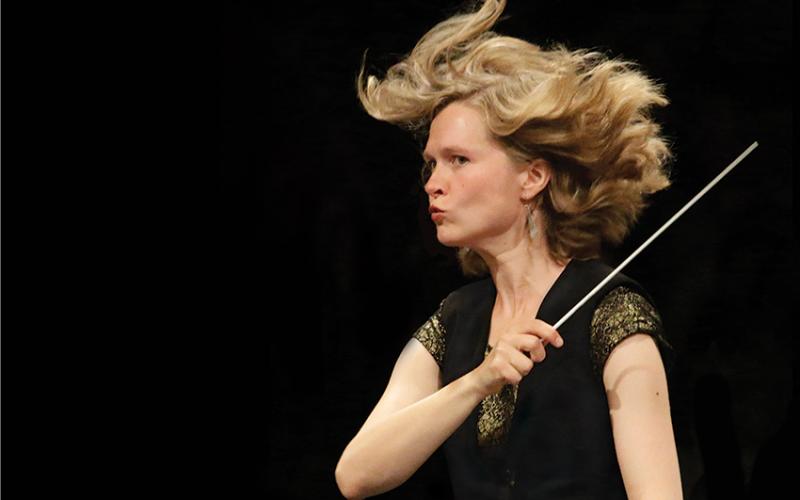
The KGB owners, the Lebedev family, have secured George Osborne, the former Chancellor of the Exchequer, as editor of the London Evening Standard, a freesheet.
They broke the news through their former pet editor of the ‘Independent’ newspaper, Amol Rajan, who is now the BBC’s media editor.
That’s how the Russians operate. They buy up politicians and plant their own people in places of influence. That Lebedev can buy a recent Chancellor shows how well they have succeeded. Osborne will remain an MP, waiting for the PM to slip on a banana skin.
We are being well and truly infiltrated.

Declaration of interest: I resigned as Assistant Editor of the Standard in 2009 when the paper was sold to the Lebedevs, and before it became a freesheet.
The realisation is dawning that when President Trump kills off the National Endowment for the Arts (NEA), Congress will never again have the guts to support culture with tax money, as it did under Lyndon Johnson’s presidency in 1965.
Here are a couple of instant institutional reactions to the Trump abolition:
Statement by American Federation of Musicians International President Ray Hair regarding President Trump’s Budget which eliminates the National Endowment for the Arts (NEA) along with 61 other government programs/agencies.
“I have said it before and I’ll say it again, eliminating the NEA is outrageous and unacceptable. There are orchestras, festivals and theaters in all 50 states that would be permanently damaged without NEA support. It is time for Congress to step up and do the right thing—safeguard the NEA by fully funding this priceless institution.”
Statement by Aaron Dworkin, dean of the University of Michigan School of Music, Theatre & Dance:
As part of the proposed new federal budget plan, it was announced on March 16, 2017, that the National Endowment for the Arts (NEA) and National Endowment for the Humanities (NEH) will be completely eliminated if approved by Congress. Funding for both groups amounted to just 0.003 percent of all federal spending in 2016, with each organization receiving approximately $148 million. Meanwhile, the nonprofit arts industry generates $135 billion in economic activity annually (spending by organizations and their audiences) that supports 4.1 million jobs and generates $22.3 billion in government revenue.
Aside from the positive economic impact realized by this small federal investment–which would no doubt increase with more funding instead of less–the NEA and NEH have a profound impact on the life of our nation; they support the heart and soul of our communities, the creative and intellectual backbone. The arts and humanities are key to innovation and inspiration, to understanding the human condition, and to addressing the complexities of our world. In addition, this small investment leverages private support from individuals, corporations and foundations to make even more impact.
In a country and time that is fractured by partisan dissent, the arts unite audiences in shared experiences, encourage civil discourse and engagement, thrive on collaboration, and celebrate diverse perspectives. And the humanities, in exploring the wide range of human culture, connect us to our past, help us understand our present, and inform us in planning for our future.
At the University of Michigan School of Music, Theatre & Dance, we are educating and training some of the country’s brightest and most talented aspiring artists and scholars in the performing arts. Fully aware of the career challenges that these young people potentially face upon graduation, we are also providing them with a robust program in entrepreneurship, to help them create their own opportunities and careers.
But even with this focus, the NEA and NEH will be critically important in helping our graduates share their incredible gifts to make a positive impact on society, because the NEA and NEH make the largest difference to the thousands of local arts and humanities programs across the nation. They are vital to the communities they serve-to organizations that introduce children to music, theatre, dance, and to other cultures … that engage our youth in after-school programs that funnel their energies into creative explorations and expanded horizons … that provide all ages with inspirational and stimulating performances, exhibits, lecture series, and more.

Trump dining at his gold-plated table
We reported one summer a few years back that Dane Johansen was walking across Spain, playing the Bach cello suites in town and village squares.
Now a movie about his pilgrimage is being premiered at the Cleveland International Film Festival.
Have a look.
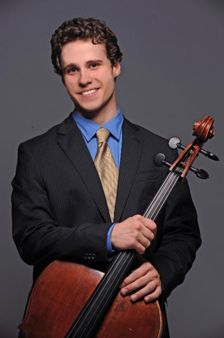
The New Bedford Symphony Orchestra has chosen Yaniv Dinur as its next music director, starting this summer.
Dinur, 36, is Ed De Waart’s assistant conductor at the Milwaukee Symphony.
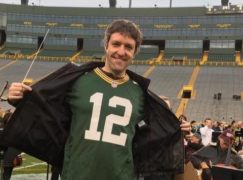
Message from Hilary:
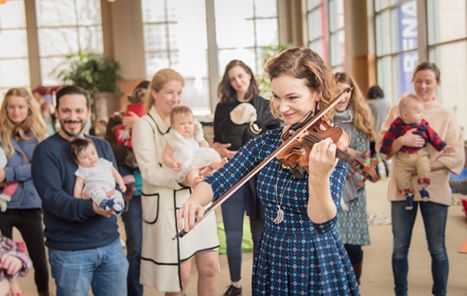
When I was a brand-new parent, I really wanted to take my baby with me to a grownup classical concert, something that I would normally attend myself. But I couldn’t find any that were geared towards the parents while welcoming babies. So I decided to fill the gap.
I started giving mini concerts for other new parents and caretakers of babies up to 8 months, to give them a break in their day, encourage them to share their love for the arts with their babies, and provide a warm experience for everyone to relax into together.
I don’t consider these “educational” concerts. They’re for the grownups, just… everyone has to bring a baby in order to get in. Audience members are free to chill out, move around, feed, bounce up and down, sit on the floor, or cry. Anything they’d normally do! I perform solo violin repertoire from my regular concerts, and at the end, everyone is invited up to the front to share a final, familiar tune. I love how unbelievably CUTE all of these concertgoers are, and they really seem to appreciate the music!
– Hilary
The weekly diary of violinist Anthea Kreston:
I am on my way to Denmark for four days. Jason is away for over two weeks now, in Japan and Korea with a Berlin orchestra. He plays two Mahler symphonies and – actually I don’t even know what else, or who the conductor is. All he tells me of rehearsals and tour are funny things that people around him do when the conductor isn’t looking – just like we all used to do in middle school and youth orchestra. There is some kind of running gag where someone from one side of the orchestra passes something to someone on the total opposite side of the orchestra.
This process takes perhaps 45 minutes or an hour, and the person who receives the item isn’t expecting it and doesn’t know why they are getting it. A furtive passing, waiting for a moment to pass to the next stand. The next day, it gets passed back, painstakingly slowly, the other way, to great hilarity upon completion. Also – overly expressively-felt long rests (20 measures or more) accompanied by nodding and large arm movements which slowly crash into and move the person’s stand behind them – farther and farther away, almost tipping. Things like this. This is how morale is kept high – how personal joy in a dictatorship (how else can an orchestra exists?) can thrive. Before he left, as we were doing our final organizing, I urged him to drink a lot, hang out with new friends, and sleep a lot on tour – enjoy the freedom! From the charges on our mutual credit card, it appears that this is being accomplished. He has worked so hard this past year – time for some well-deserved play!
My mother is here for twelve of the days – I still have teaching, rehearsing, and tours while he is gone. Every minute is organized, and there is often a sitter to assist when I am away from home – with picking up a daughter, getting groceries, etc.
While Jason is away, I am again practising with the girls (grandma practices piano with them and I do violin and cello). Something happened the other day, which I am still wrapping my head around. I was practising with our five year old, and I went into the other room to get a new piece. Reiding Op. 35 – a concerto in 3 movements, all in 1st position. Someone gave this to me several years ago, and I fell in love with it – it is complex musically – it has a dark personal first theme and also a heroic, bold second theme. It is in first position, so anyone who has made it through book 1 suzuki can play it. I have taught it now perhaps a half-dozen times. Usually pieces for kids are happy, light dances, but this piece develops an emotional complexity, and possibly the beginning of an addiction to discovery of shades of feeling.
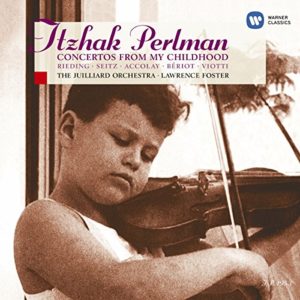
I asked my daughter if she wanted to learn her first concerto and she said she did. I played the first two phrases for her, and I noticed her eyes became covered – she was trying to remain stoic as her lower lip trembled and large tears began to slide down her cheeks. I stopped and asked if she was ok. She asked, “mom – what is that piece about?”. I said I didn’t know, and yet she insisted. I made up a story about a warrior princess who lost her horse, and was looking for it in the forest so she could save the day (which I demonstrated with the happy second theme).
She said she wanted to try to learn it, and after we played the first phrase a couple of times, she again began to cry, privately. I hugged her and said we could pick a different piece. Nevertheless, she persisted – she was still interested in learning it. We listened to Perlman play it – from his album “Concertos from my Childhood”, and I do admit it is very sad at the beginning. We listened all the way to the happy second theme.
We tried it again the second day, and also talked about it on the way home from kindergarten. We sang the piece – she said it only sounded sad when a violin played it. I asked her if she had ever felt sad in the same way as when she heard this piece, and she said no. In the end, we agreed to find another concerto, but a happy one.
Of course we know that humans are deeply feeling, from the first moments of life. But, this reaction was so intuitive, strong and immediate. What was the trigger? How does music reach us, and why? I talked to her about how feeling sad is normal, how there is a happy part later, and by feeling sad first, the happy part is even happier. “Saving the Day” always requires sacrifice and almost-insurmountable obstacle. But she would have none of it. Back to “squirrel song” for us, for now – but maybe it can be a Princess Warrior Squirrel.









